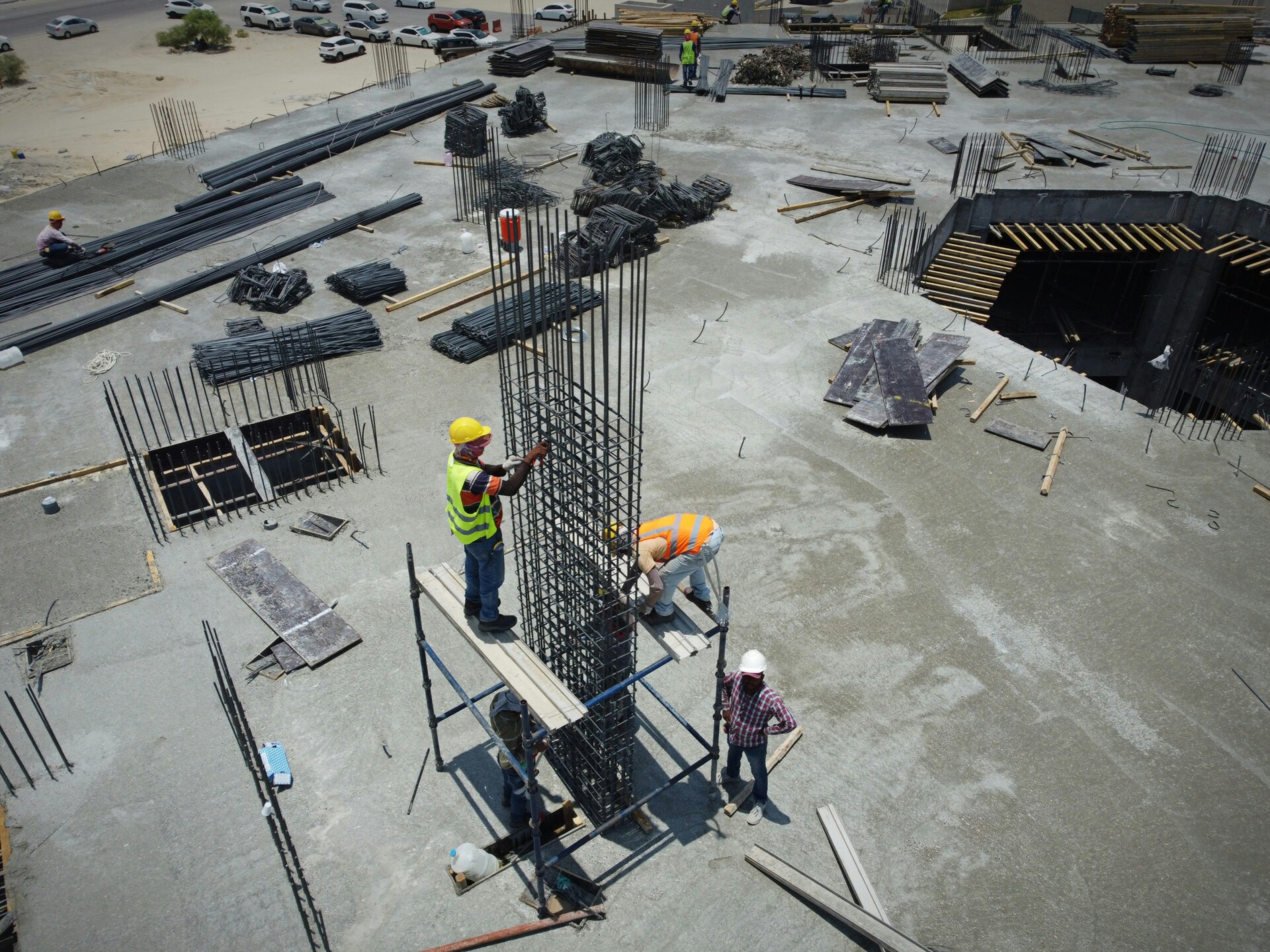A project manager for a general contractor commands every construction phase from planning to delivery. We take full ownership of scheduling, budget oversight, and stakeholder coordination throughout the build process.
Construction projects demand someone who connects owners, architects, engineers, superintendents, and subcontractors under one unified approach. The project manager becomes the central hub that ensures contract compliance, building code adherence, and timeline execution across all moving parts.
What Are The Core Responsibilities On GC Projects?

We handle eight critical areas that determine project success. Each responsibility builds on the others to maintain cost, schedule, quality, and safety standards throughout construction.
- Bidding and preconstruction form the foundation. We support RFP, RFQ, and ITB responses by analyzing project drawings and scope requirements. During design-build or design-bid-build pursuits, we provide early input on constructability, material selection, and phasing strategies that impact both cost and timeline.
- Schedule and budget control requires constant coordination. We create the master schedule with detailed sequencing of all trades and activities. Working with the superintendent, we build look-ahead schedules that identify upcoming work and potential conflicts. Milestone tracking against planned versus actual cost and time allows us to adjust resource allocation before problems escalate.
- Subcontractor management drives project execution. We qualify trades based on experience, bonding capacity, and safety records. Once hired, we coordinate work sequences to prevent conflicts and ensure alignment with project specifications and general conditions. This includes managing workforce planning to maintain productivity without overcrowding the site.
- Materials and logistics prevent costly delays. We procure materials according to the schedule, coordinate delivery timing with trade activities, and conduct inspections upon arrival. Proper storage management protects materials from damage and theft while maintaining site organization for efficient workflow.
- Permits and approvals ensure legal compliance. We coordinate required building permits, utility connections, and special approvals with local authorities. Maintaining current knowledge of building codes and regulations helps us navigate inspection requirements and address compliance issues before they impact the schedule.
- Quality and safety anchor our daily operations. We conduct regular site inspections using standardized checklists that cover workmanship standards and safety protocols. Weekly trade meetings address immediate concerns and reinforce compliance with project specifications and OSHA requirements.
- Change management protects project margins. We identify scope changes early, document existing field conditions thoroughly, and prepare detailed change orders with cost and schedule impacts. Proper tracking ensures all changes are approved and incorporated into updated project documents.
- Progress tracking maintains project momentum. Regular site visits allow us to verify work against schedules, respond to delays or emergencies, and adjust resource plans. Consistent reporting keeps all stakeholders informed of project status and upcoming critical activities.
How Does The Project Manager Coordinate The Team And Stakeholders?
The project manager serves as the primary communication hub between all parties on a construction job. We maintain regular touchpoints across different groups to keep information flowing and prevent miscommunication that can derail progress.
Daily interface points connect us directly with field operations. We work closely with the superintendent to review progress, discuss upcoming activities, and address immediate challenges. Regular communication with subcontractors ensures their work stays sequenced properly and aligns with the master schedule. We also coordinate with suppliers on deliveries and material specifications to prevent delays.
Meeting Leadership And Coordination
We lead weekly trade coordination meetings to synchronize subcontractor activities and resolve conflicts before they impact the critical path. These sessions focus on the immediate look-ahead schedule and identify potential bottlenecks.
Owner-architect-contractor meetings form another cornerstone of stakeholder management. These OAC meetings bring together decision-makers to address design questions, review progress against milestones, and align on next steps. We create agendas that prioritize items affecting schedule, budget, or design and facilitate discussions that lead to actionable decisions.
Progress Reporting And Updates
We compile field reports from the superintendent into concise stakeholder updates that highlight key metrics. These reports cover cost performance against budget, schedule adherence, risk factors, and quality observations. The format varies by audience, with detailed technical updates for the design team and high-level summaries for ownership groups.
Regular reporting cycles keep all parties informed without overwhelming them with unnecessary detail. We focus on variances from plan, upcoming critical activities, and items requiring stakeholder input or approval.
Field Presence And Problem Resolution
Site walks provide direct observation of work in progress and create opportunities to answer questions from trades and field personnel. These visits help us verify that work matches drawings and specifications while identifying potential issues early.
Field presence also enables quick problem-solving. When subcontractors encounter unclear details or field conditions that differ from plans, we can assess the situation immediately and coordinate with the appropriate parties for resolution.
Documentation Management
We manage the flow of project documentation to maintain current and auditable records. This includes processing RFIs when contractors need clarification on drawings or specifications. We route these requests to the appropriate design professionals and track response times to prevent delays.
Submittal management ensures that product selections, shop drawings, and material samples get reviewed and approved according to project requirements. We coordinate the review process between subcontractors, design professionals, and ownership while maintaining approval logs for reference.
Change logs document field conditions, design modifications, and scope adjustments throughout the project. We prepare change order documentation, coordinate approvals, and track impacts to both schedule and budget. Addenda and other project modifications get distributed to all relevant parties with proper version control.
What Qualifications And Skills Strengthen This Role?

Project managers in general contracting firms carry significant responsibility across complex construction projects. Building the right foundation of education, experience, and specialized skills creates the expertise needed to coordinate schedules, manage budgets, and deliver quality results on time.
Educational Foundation And Professional Training
Most employers prefer candidates with a bachelor’s degree in construction management, construction science, engineering, architecture, or business administration. These programs provide essential knowledge in project scheduling, cost estimation, contract interpretation, and building systems integration.
On-the-job training remains equally valuable in developing practical competencies. We see many successful project managers who started in entry-level positions and gained expertise through hands-on experience with construction processes, subcontractor relationships, and field problem-solving. This combination of formal education and real-world application creates well-rounded professionals who understand both theory and practice.
Career Advancement Pathways
Several routes lead to project manager positions within general contracting organizations. Many professionals advance from assistant project manager or project engineer roles, where they learn to support senior staff while developing technical and coordination skills.
Others rise through the trades, progressing from craftworker to foreman to superintendent before transitioning into project management. This pathway brings deep understanding of construction methods, workforce dynamics, and field conditions. These individuals often excel at practical problem-solving and maintaining strong relationships with trade contractors.
Professional Certifications That Add Value
Industry certifications demonstrate commitment to professional development and specialized expertise. The Certified Construction Manager (CCM) from the Construction Management Association of America represents the gold standard for construction management professionals. This credential requires extensive experience, formal training, and passing a comprehensive examination covering project delivery, risk management, and professional practices.
The Certified Professional Constructor (CPC) from the American Institute of Constructors validates expertise in construction processes and project execution. The Project Management Professional (PMP) certification brings broader project management principles that apply across industries, including advanced risk management and stakeholder communication techniques.
LEED Accredited Professional credentials become increasingly valuable as sustainable construction grows. OSHA 10 and 30-hour safety training demonstrates safety awareness and regulatory compliance knowledge. First Aid and CPR certifications show commitment to worker safety and emergency preparedness.
Core Leadership And Technical Competencies
Effective project managers combine strong leadership abilities with technical construction knowledge. Leadership skills include team motivation, conflict resolution, and decision-making under pressure. Communication capabilities must span from detailed technical discussions with engineers to budget presentations for ownership groups.
Analytical and decision-making abilities prove critical when evaluating alternatives, assessing risks, and solving field problems. Contract and drawing literacy allows project managers to interpret specifications, identify potential issues, and communicate requirements clearly to trade contractors. Risk and cost control skills help maintain project profitability while delivering quality results.
Time management becomes essential when balancing multiple projects, coordinating numerous stakeholders, and responding to urgent field conditions. Project managers must prioritize competing demands while maintaining focus on critical path activities and milestone delivery.
Regulatory Knowledge And Compliance Requirements
Understanding local licensing rules, lien laws, and building codes ensures projects meet legal requirements and avoid costly delays. Project managers must stay current with evolving regulations, permit processes, and inspection requirements in their markets.
Insurance requirements vary by jurisdiction and project type. Maintaining appropriate coverage and understanding policy terms protects both the contracting firm and project stakeholders. Knowledge of bonding requirements and procedures supports successful project delivery and client relationships.
How Does This Role Compare To A Construction Manager And The General Contractor?
Understanding the distinctions between a project manager within a general contractor firm, the general contractor entity itself, and a construction manager helps clarify these often-overlapping roles. The timing of engagement, contract structure, and reporting relationships create meaningful differences in how each position operates.
Within a general contractor firm, the project manager functions as the operational lead for specific projects. We coordinate subcontractors, maintain schedules, control costs, and ensure quality under the broader company structure.
The general contractor operates as the primary contracting entity with the owner. After winning work through competitive bidding, we take full responsibility for project delivery. Most general contractor agreements use lump-sum or stipulated sum terms, where we assume financial risk for cost overruns while managing all site activities and subcontractor relationships.
Construction managers typically engage much earlier in the project lifecycle. During the design phase, they provide constructability input, refine plans, and help control costs before construction begins. Construction managers commonly work on a fee basis, earning compensation regardless of project cost performance, which shifts financial risk compared to lump-sum contracting.
The construction manager’s role as an owner’s representative differs significantly from how we operate as general contractors. While we execute the work and assume performance risk, construction managers advise owners and oversee our work without direct construction responsibility. This creates distinct accountability structures and reporting relationships.
Contract type often distinguishes these roles in practice. Design-bid-build delivery methods typically feature general contractors taking on projects after design completion. Design-build approaches may involve either general contractors or construction managers, depending on the specific arrangement and risk allocation.
Industry usage can blur these distinctions. Titles overlap, and responsibilities shift based on project delivery method, owner preferences, and company capabilities. However, the fundamental differences in timing, contract structure, and owner relationships remain consistent. Project managers within GC firms focus on execution, general contractors assume comprehensive project responsibility, and construction managers provide advisory oversight throughout the project lifecycle.
Conclusion And Next Steps

A project manager for a general contractor drives scope, schedule, budget, and quality while keeping all parties aligned. We position ourselves at the center of every project to coordinate owners, architects, engineers, superintendents, and subcontractors through the construction lifecycle. This role demands both strategic oversight and hands-on coordination to deliver projects on time, within budget, and to specified quality standards.
To excel in this position, we focus on five actionable areas that strengthen project outcomes. First, engage early in preconstruction to identify risks, align expectations, and establish clear communication protocols before construction begins. Build reliable schedules and look-ahead schedules that account for weather, material deliveries, and trade sequencing to maintain project momentum. Standardize safety and quality checklists that ensure consistent inspections and compliance with building codes and specifications. Document all changes through proper change management processes to maintain accurate project records and protect against disputes. Run consistent OAC meetings and trade coordination sessions to keep stakeholders informed and address issues before they become delays. Strengthen long-term results by developing technical fluency in construction methods, building strong communication habits with all project stakeholders, and earning credentials that align with local codes and delivery methods.
Ready to take your construction projects to the next level? Contact EB3 Construction today to discuss how we can bring our project management expertise to your next build.




